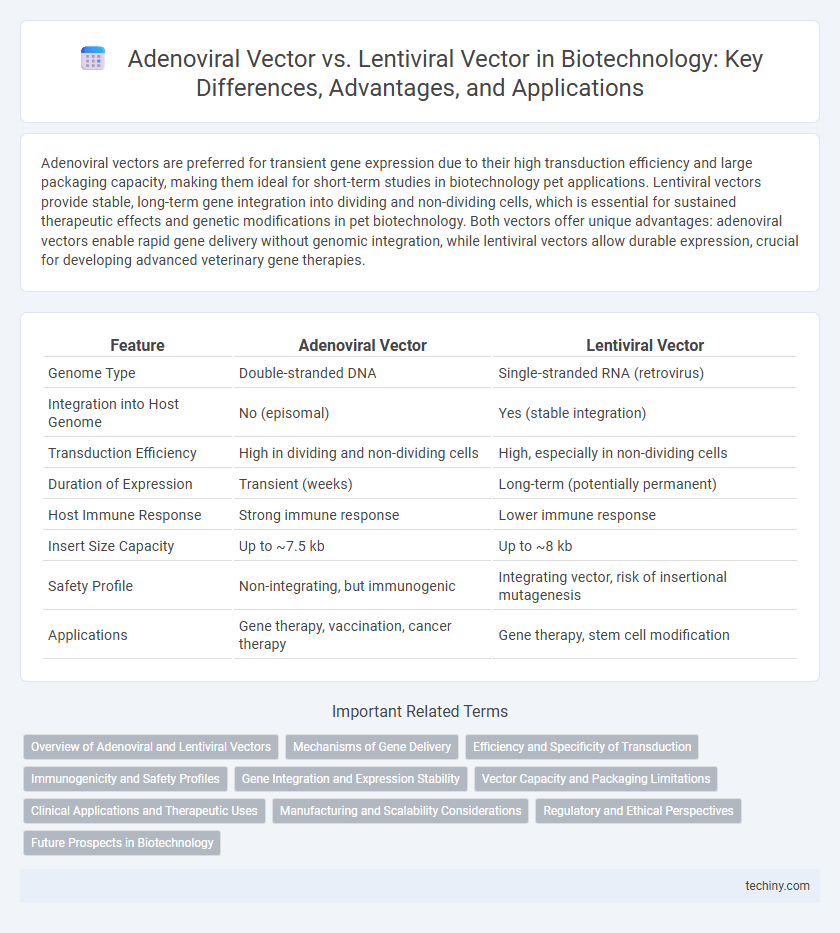Adenoviral vectors are preferred for transient gene expression due to their high transduction efficiency and large packaging capacity, making them ideal for short-term studies in biotechnology pet applications. Lentiviral vectors provide stable, long-term gene integration into dividing and non-dividing cells, which is essential for sustained therapeutic effects and genetic modifications in pet biotechnology. Both vectors offer unique advantages: adenoviral vectors enable rapid gene delivery without genomic integration, while lentiviral vectors allow durable expression, crucial for developing advanced veterinary gene therapies.
Table of Comparison
| Feature | Adenoviral Vector | Lentiviral Vector |
|---|---|---|
| Genome Type | Double-stranded DNA | Single-stranded RNA (retrovirus) |
| Integration into Host Genome | No (episomal) | Yes (stable integration) |
| Transduction Efficiency | High in dividing and non-dividing cells | High, especially in non-dividing cells |
| Duration of Expression | Transient (weeks) | Long-term (potentially permanent) |
| Host Immune Response | Strong immune response | Lower immune response |
| Insert Size Capacity | Up to ~7.5 kb | Up to ~8 kb |
| Safety Profile | Non-integrating, but immunogenic | Integrating vector, risk of insertional mutagenesis |
| Applications | Gene therapy, vaccination, cancer therapy | Gene therapy, stem cell modification |
Overview of Adenoviral and Lentiviral Vectors
Adenoviral vectors are non-enveloped viruses with double-stranded DNA capable of transducing dividing and non-dividing cells, offering high transgene expression but eliciting strong immune responses that limit their duration in vivo. Lentiviral vectors, derived from HIV-1, are enveloped RNA viruses that integrate into the host genome, enabling stable and long-term gene expression in both dividing and non-dividing cells with lower immunogenicity. Both vectors serve distinct roles in gene therapy applications, with adenoviral vectors favored for transient expression and lentiviral vectors for permanent genetic modification.
Mechanisms of Gene Delivery
Adenoviral vectors deliver genes by attaching to cell surface receptors and entering cells through receptor-mediated endocytosis, facilitating transient gene expression without integrating into the host genome. Lentiviral vectors transduce target cells by fusing with the cell membrane and reverse-transcribing RNA into DNA, which integrates stably into the host genome for long-term gene expression. The distinction in integration mechanisms influences the duration and safety profile of gene therapy applications using these viral vectors.
Efficiency and Specificity of Transduction
Adenoviral vectors exhibit high transduction efficiency in both dividing and non-dividing cells but often trigger strong immune responses limiting their specificity and duration of expression. Lentiviral vectors integrate into the host genome, providing stable and long-term gene expression with high specificity, particularly in dividing cells, while eliciting lower immunogenicity. The choice between adenoviral and lentiviral vectors depends on the desired balance between transduction efficiency, cellular specificity, and safety for therapeutic applications.
Immunogenicity and Safety Profiles
Adenoviral vectors exhibit high immunogenicity due to pre-existing immunity and strong inflammatory responses, posing challenges for repeated administrations. Lentiviral vectors demonstrate lower immunogenicity, allowing for sustained gene expression with reduced host immune activation. Safety profiles favor lentiviral vectors as they integrate into the host genome, enabling stable transgene expression, while adenoviral vectors remain episomal but may induce cytotoxicity and strong immune reactions.
Gene Integration and Expression Stability
Adenoviral vectors provide transient gene expression without integration into the host genome, reducing risks of insertional mutagenesis but limiting long-term gene stability. Lentiviral vectors integrate stably into the host genome, enabling sustained gene expression ideal for permanent genetic modification. The stable integration of lentiviral vectors supports long-term therapeutic efficacy in gene therapy applications, unlike the episomal persistence of adenoviral vectors.
Vector Capacity and Packaging Limitations
Adenoviral vectors offer a high packaging capacity of up to 36 kilobases, enabling the delivery of larger transgenes or multiple genes simultaneously, which is advantageous for complex gene therapies. Lentiviral vectors have a smaller packaging limit, typically around 8 to 10 kilobases, restricting the size of therapeutic genes but allowing stable integration into the host genome for long-term expression. Packaging limitations in adenoviral vectors often result from capsid constraints, while lentiviral vector capacity is limited by the size of the viral RNA genome and the efficiency of reverse transcription.
Clinical Applications and Therapeutic Uses
Adenoviral vectors are widely used in gene therapy for cancer immunotherapy and vaccine development due to their high transduction efficiency and strong transient expression in both dividing and non-dividing cells. Lentiviral vectors offer stable, long-term gene expression by integrating into the host genome, making them ideal for treating genetic disorders such as b-thalassemia and HIV. Clinical applications of lentiviral vectors include hematopoietic stem cell modification, while adenoviral vectors excel in oncolytic virotherapy and respiratory disease vaccines.
Manufacturing and Scalability Considerations
Adenoviral vectors offer high-titer production with relatively straightforward upstream manufacturing processes using adherent or suspension cell cultures, supporting rapid scalability for large-scale applications. Lentiviral vectors require more complex production involving transient transfection in HEK293T cells and often face challenges in achieving high yields and consistent quality, impacting scalability. Process optimization and advancements in stable producer cell lines are critical for improving lentiviral vector manufacturing efficiency and scalability in clinical and commercial settings.
Regulatory and Ethical Perspectives
Adenoviral vectors are often favored in clinical trials due to their transient expression and lower risk of insertional mutagenesis, easing regulatory constraints related to genome integration. Lentiviral vectors, while offering stable gene expression through integration, face stricter scrutiny from regulatory agencies because of potential oncogenesis and long-term safety concerns. Ethical considerations emphasize informed patient consent and risk-benefit analysis, particularly for lentiviral applications where genomic alteration poses irreversible consequences.
Future Prospects in Biotechnology
Adenoviral vectors, known for transient gene expression and high immunogenicity, show promise in cancer immunotherapy and vaccine development due to their robust transduction efficiency in dividing and non-dividing cells. Lentiviral vectors offer stable, long-term gene integration with lower immunogenicity, making them ideal for gene therapy targeting hereditary diseases and stem cell modification. Advances in vector engineering, such as reducing immunogenicity and enhancing targeting specificity, are expected to expand their clinical applications and improve safety profiles in future biotechnological innovations.
Adenoviral vector vs Lentiviral vector Infographic

 techiny.com
techiny.com